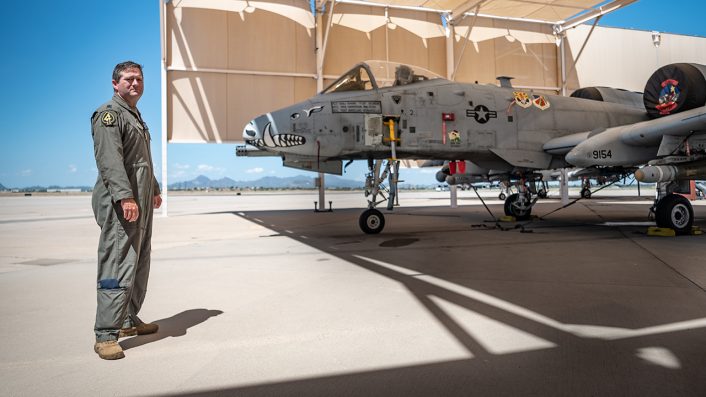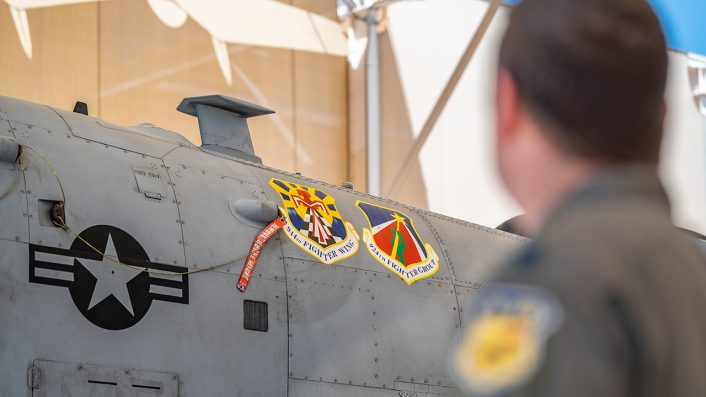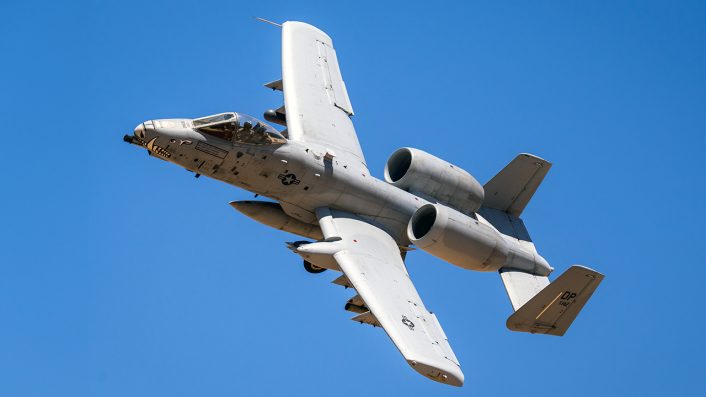Lt. Col. Mitchell recalls a life-or-death moment in the sky, helping his wingman fight hypoxia during a mission aboard the A-10 Warthog.
With the plan to fully retire the type by 2029, the U.S. Air Force will decommission 42 A-10C Thunderbolt II aircraft this year, with the remaining 260 expected to be phased out in the next 5 years.
As the legendary “Warthog” approaches the twilight of its storied service, one figure stands out as a living embodiment of the grit, tenacity, and unwavering dedication that define the aircraft’s tight-knit community. That figure is U.S. Air Force Reserve Citizen Airman Lt. Col. Timothy “Scream” Mitchell.
With nearly two decades of flying the A-10, Mitchell was recently recognized with a prestigious safety award, not only for his actions during a perilous night flight but for a career that epitomizes the spirit of the A-10 and the individuals who support and operate this combat-proven aircraft.
In March this year, Mitchell found himself in a situation that tested the full breadth of his experience. Alongside Capt. Dylan “Mac” Vail, an active-duty pilot from the 357th Fighter Squadron who was being trained to become an IP (instructor pilot), Mitchell embarked on what was intended to be a routine 2-ship training flight.

As an instructor pilot and flight commander for the 47th Fighter Squadron, Mitchell is no stranger to demanding situations. However, on this night, what began as a standard night sortie, would quickly transform rom routine to critical. In fact, Vail began showing the early signs of hypoxia, a dangerous condition caused by a lack of oxygen that can impair cognitive functions and motor skills.
A subtle threat
Hypoxia can be difficult to identify, especially for pilots, because its onset is often gradual and its symptoms can be subtle or easily mistaken for fatigue or stress. Symptoms like dizziness, confusion, lightheadedness, euphoria, and impaired judgment often develop slowly, which can make it challenging for pilots to recognize what is happening before it becomes severe, and increasingly difficult for a pilot to maintain control of their aircraft.
In the cockpit, Vail was struggling. His brain, starved of oxygen, couldn’t process the situation clearly. As the effects of hypoxia worsened, the situation became dire. But Mitchell’s calm and decisive leadership shone through. Years of experience kicked in, allowing him to quickly assess the situation and provide clear, concise instructions over the radio to guide Vail back to safety.
It was a night that could have ended tragically had it not been for Mitchell’s steady hand.
“I could barely think straight,” Vail recalls, his voice heavy with the memory of that critical night. A Houston native and a graduate of the Air Force Academy, Vail was in a dangerous spiral, both mentally and physically. “Mitchell was there every step of the way, simplifying everything, telling me exactly what I needed to do. It was his voice and experience that got me back on the ground safely.”
For Vail, Mitchell’s actions went beyond the role of an experienced pilot, they embodied a deeper philosophy, one ingrained in the A-10 community itself. This is a community where the mission is paramount, but equally important is the unwavering commitment to the safety and well-being of those involved.
“People always get lost and enamored about the aircraft,” Mitchell explained. A native of Lockney, Texas, and a graduate of Texas A&M, Mitchell is quick to shift the spotlight away from himself and the aircraft, instead highlighting the broader community that supports the A-10. “But the number one thing is the community that is dedicated to it.”
For Mitchell, the A-10 is not just a machine. It’s a symbol of camaraderie, a tool to defend and protect, and a centerpiece of a community bound by shared purpose and dedication. Standing next to the very first A-10 he flew, tail number 9154, Mitchell reflected on his long journey with the aircraft. His humor remained intact despite the passage of time and the wear of years spent in service.
“I’m old,” he said with a chuckle, recalling his search for some of the A-10s he had flown over the years. “I was trying to look for a couple of tails that I had my name on in the past, and I think they’re gone either to Moody AFB or the Boneyard, so here’s what it is.”
Mitchell’s reflections extend beyond the aircraft’s flight numbers and history. He shared a little-known piece of A-10 heritage, the unique artwork that adorns each of the 47th Pursuit Squadron’s aircraft. Dating back to World War II, these aircraft are emblazoned with characters from the “Dogpatch” cartoon series by Andy Capp, a tradition that the squadron continues to honor.
“The 47th Pursuit Squadron paid Andy Capp $1 for the copyright usage of his characters to put on all the airframes,” Mitchell shared, highlighting the deep historical roots that tie the squadron to the past. “Each airplane has its own character from the original Little Abner cartoons.”

This rich tradition, combined with a sense of pride and duty, has been a cornerstone of Mitchell’s career since he first began flying the A-10 in January 2005. From those early days as a young lieutenant in the 47th Fighter Squadron to his current role as a seasoned commander and mentor, Mitchell’s journey has been defined by his commitment to not only the aircraft but also the people who operate and maintain it.
“Creating new fighter pilots and passing on the lessons learned—that’s our job,” Mitchell said, emphasizing the importance of mentorship within the A-10 community. “We are providers of fixing problems for people in a dynamic situation, and we’re very good at it.”
Col. Aaron “Nacho” Weedman, commander of the 924th Fighter Group, also expressed pride in Mitchell’s efforts. He highlighted the significance of Mitchell’s actions during that night flight and the profound impact of his leadership on the A-10 community.
“His actions while instructing a student during a sortie in which the student experienced a serious physiological incident saved the life of another pilot,” Weedman said. For Weedman, Mitchell’s recent safety award is not just a personal achievement but a reflection of the ethos that has guided the A-10 community for decades.
The citation for the award specifically notes Mitchell’s quick thinking during the March 2024 incident, as well as his broader contributions to the safety and training of A-10 pilots. But as Weedman pointed out, the recognition also speaks to the experience and maturity that AFRC Instructor pilot cadre like Mitchell bring to the mission of the A-10 Formal Training Unit.
“His actions that evening highlight the importance of experience and maturity that AFRC Instructor pilot cadre add to the mission of the A-10 FTU,” Weedman emphasized. “This experience is leveraged to strengthen the total force, producing combat-ready wingmen for the A-10 community.”
More than just an aircraft
For pilots like Mitchell and Vail, the A-10 is far more than just an aircraft. It symbolizes something much greater, a legacy of camaraderie, dedication to mission, and the enduring reputation of those who have flown it and those who have been saved by it.
Vail, now a certified instructor pilot himself, is keenly aware of the legacy he is inheriting. It is a legacy shaped by the seasoned pilots who came before him—pilots like Mitchell, who ensured the lessons of the past continue to guide the future.
“I love the A-10. I love the mission,” Vail shared. “But what makes it special is the people, the community of pilots who have dedicated themselves to this aircraft and what it stands for.”
As the A-10 gradually phases out of U.S. military service (with a potential future in a foreign air arm), its heritage will not fade away with its airframes. Instead, it will live on in the stories and experiences of those who flew it, those who maintained it, and those whose lives were saved by it. And in the center of that story will always be the men and women like Lt. Col. Timothy “Scream” Mitchell, whose actions ensured that every pilot returned home safely.


